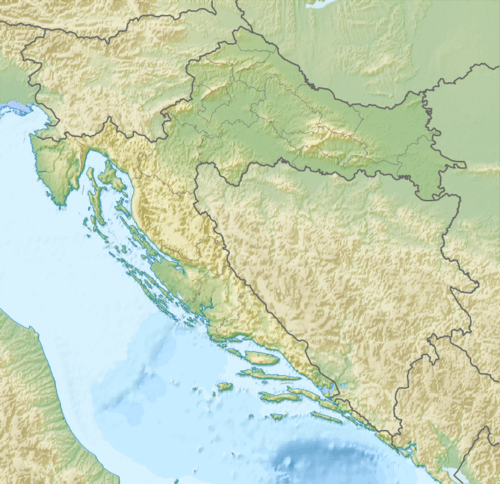Croatian Air Force and Air Defence
| Croatian Air Force | |
|---|---|
 Emblem of the Croatian Air Force | |
| Active | 1991–present |
| Country | Croatia |
| Type | Air force |
| Role | Aerial warfare |
| Size | 1,454 personnel[1] |
| H/Q | Pleso Air Base |
| Motto(s) | Hrvatskim nebom bdiju i plove (Croatian Sky they Guard and Fly) |
| Anniversaries | December 12 |
| Equipment | 94 aircraft |
| Engagements | KFOR |
| Commanders | |
| Current commander | Brigadier general Mato Mikić |
| Notable commanders | General Imra Agotić |
| Insignia | |
| Roundel |
  |
| Fin Flash |
 .svg.png) |
| Aircraft flown | |
| Fighter | MiG-21bisD |
| Attack helicopter | OH-58D |
| Patrol | PC-9M, Bell 206B-3 |
| Trainer | Z 242L, PC-9M, MiG-21UM, Bell 206B-3 |
| Transport | Mi-8MTV-1, Mi-171Sh |
The Croatian Air Force (Croatian: Hrvatsko ratno zrakoplovstvo or HRZ) is a branch of the Croatian Armed Forces whose primary task is to ensure the sovereignty of the airspace of the Republic of Croatia and to provide aviation support to other branches in the implementation of their tasks in joint operations. It is also the carrier and the organizer of the integrated anti-aircraft defense system of the Republic of Croatia.
Aviation history
The Croatian Air Force as it is known today was established on 12 December 1991, during the Croatian War of Independence. After 2003, a large portion of the fleet was modernized or completely overhauled and the rest of the outdated fleet was retired. Croatia also acquired new-build transport helicopters, fire-fighting aircraft and basic training aircraft during this time. The planned acquisitions for additional fixed- and rotary-wing transports and fighter aircraft were, after repeated postponements, cancelled due to a difficult economic situation.
Duties
The primary role of the Croatian Air Force and Air Defence is securing the sovereignty of Croatian air space and providing air support to other services during joint operations. It operates the integrated Croatian Air Defence system. Other tasks include providing help in natural, humanitarian and technological disasters, search and rescue operations, and support to other government agencies.
Commanders
Commanders of the Croatian Air Force since its establishment in 1991:
- Imra Agotić (1991–1996)
- Josip Čuletić (1996–2001)
- Josip Štimac (2001–2002)
- Viktor Koprivnjak (2002–2007)
- Vlado Bagarić (2007–2011)
- Dražen Šćuri (2011–2016)
- Miroslav Kovač (2016–2018)
- Mato Mikić (2018–present)
Structure

- Air Force and Air Defense Command, in Zagreb[2]
- Command Company, in Pleso (Zagreb Airport)
- 91st Air Force Base, in Pleso
- Command Company
- Fighter Aircraft Squadron, flying MiG-21bisD/UMD
- Transport Aircraft Squadron, flying An-32B
- Multirole Helicopter Squadron, flying Mi-171Sh (at 94th Air Force Base, in Lučko)
- Aeronautical Technical Battalion
- 93rd Air Force Base, in Zadar
- Command Company
- Transport Helicopter Squadron, flying Mi-8 MTV-1 (at 95th Air Force Base in Divulje)
- Aircraft Training Squadron, flying PC-9M, Zlin 242L (at 92nd Air Force Base in Pula)
- Firefighting Squadron, flying CL-415, AT-802A/F FireBoss
- Combat Helicopter Squadron, flying OH-58D, Bell 206B-3
- Aeronautical Technical Battalion
- Airspace Surveillance and Control Battalion, at 91st Air Force Base
- Airspace Surveillance Center, in Podvornica, reports to NATO's Integrated Air Defense System CAOC Torrejón in Spain
- Sector Operation Center, in Split to coordinate with the Croatian Coast Guard
- Mount Sljeme, Borinci, Papuk, Učka and Mount Rota radar posts with AN/FPS-117 radars
- Radio-technical Maintenance and Support Company, at 91st Air Force Base
- Air Force Training Center "Rudolf Perešin", at 93rd Air Force Base
Status
The core of the air force is a squadron of 12 modernized MiG-21bisD/UMD fighters. In 2003, a minor upgrade and an extensive overhaul were performed in Romania, incorporating navigation and communication elements of the Lancer standard to make them interoperable with NATO air forces. The aircraft received no upgrade to their weapons systems. Despite initial plans to replace the MiG-21 fleet with a multirole aircraft in 2013 (delayed from 2011 due to the financial crisis) and an official tender having been issued in 2008, ongoing budgetary constraints have resulted in an abandonment of these plans. As a cost-saving measure, a decision was made to again overhaul seven serviceable airframes already in service and supplement them with five additional airframes from Ukrspetsexport. This temporary measure will see the fleet remain in service only until 2019-2020.
Pilot training is conducted on two types of aircraft. During late 2007, five new Zlin 242L Aerobatic basic trainers were acquired in order to replace a fleet of seven old Utva 75s (four had already been retired previously). The deal was worth just under $2 million. An option for three additional basic trainers was considered but has not been exercised. The backbone of the training fleet, however, is built around 20 Pilatus PC-9M advanced trainers which also constitute the most numerous type of aircraft in Croatian service. These were ordered in 1997 (3 were former RAAF PC-9A examples converted to PC-9M standard immediately upon delivery) and entered full service a year later. The deal was worth around $100 million. They are also operated by the national aerobatic team called Krila Oluje / Wings of Storm. The fleet size and facilities at Zemunik airbase allow the Croatian Air Force to offer advanced pilot training to other countries but the lack of HUDs, HOTAS and hardpoints on Croatia's PC-9Ms, however, limits the usefulness of Croatia's advanced training programme. Such upgrades might be financially plausible once surplus PC-9Ms get sold. Nonetheless, on March 5, 2014, representatives of the Croatian Air Force signed an agreement with their partners from the Royal Air Force of Oman for the future training and education of 16 Omani pilots on the Croatian fleet of Pilatus PC-9Ms. The training itself started on March 10, is planned to be concluded by December 26, 2014 and will see each pilot log 150 flight hours during the ten-month period. As a cost-saving measure, the Croatian government has announced in its long-term defence plan that it plans to downsize the PC-9M fleet to a "suitable level" for the current air force fleet, substantially reduced since the mid-1990s. Consequently, six oldest units are offered for sale while the 14 remaining aircraft are due to remain active and possibly undergo an upgrade.
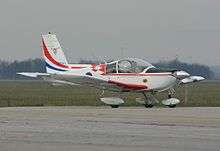
The Croatian Air Force operated two Antonov An-32B tactical transports (built in 1991 and 1993) until 2013. Both aircraft underwent a two-stage modernization in 2004 and 2007. They were fitted with NATO-standard navigational and communication equipment, additional systems for loading/unloading and flare dispensers. They had performed humanitarian and paratrooper missions as well as supporting Croatia's international military commitments such as for ISAF and KFOR. Due to budget limitations both aircraft have been offered for sale.[3] In the draft of the strategic defence review, the Croatian government announced that no new tactical transport aircraft would be purchased before 2020 leaving Croatia reliant on its NATO partners for fixed-wing transport.
The helicopter fleet is equipped mainly with Russian-built Mi-17s and its derivates. The fleet includes three Mi-8 and 11 Mi-8MTV-1 (also known as Mi-17-1V) cargo helicopters, which underwent overhauls between 2003 and 2005. A batch of 6 Mi-8MTV-1 underwent an overhaul again in 2013 and 2014, while the remaining 8 units are to follow in 2014 and 2015. The Croatian Ministry od Defence is considering the option of selling all Mi-8 helicopters upon overhaul and replacing them with up to 15 UH-60L after 2017.[4]
In 2006, a deal to deliver 10 new Mi-171Sh transport-attack helicopters was signed with Russia, itself a partial payment for an old Russian debt. The order itself was worth $66 million. The new type differs from the ones already in service in having a cargo ramp instead of clamshell doors, larger side doors, flare dispensers, additional armor around the cockpit and cargo compartment, night vision device equipment, door gunner posts, rocket launchers etc. The entire squadron of 10 helicopters entered service by July 2008. Two additional VIP helicopters were planned for 2009 but their acquisition was cancelled.
After more than 10 years in the Croatian service and great success in Operation Storm, the government finally decided to retire a squadron of seven Mi-24V helicopters in 2005 due to a costly modernization. Six are offered for sale at a price of $83,000 per aircraft, while one was sent to a museum. The role of an armed support helicopter was taken over by new Mi-171s but the entire attack helicopter squadron is to be revived in 2015 with the acquisition of up to 16 OH-58D.[4]
While visiting Israel in November 2006, Croatian delegation agreed to buy two mid-size, state-of-the-art Hermes 450 and four small Skylark UAVs. Additional cameras, computer systems, spare parts and a ground station were also obtained. Two additional Skylark UAVs entered service in 2009. As of December 2012, additional Skylarks has been reported in service though no public records or images of Croatian Hermes 450 are available. This suggests that the order was cancelled due to funding issues.
After a horrible fire season during the summer of 2007 (12 firefighters lost their lives on a small island of Kornati), Croatia agreed to buy two new Canadair CL-415 and five Air Tractor AT-802 water bombers. These joined a fleet of four relatively new amphibians already in service. The entire deal was projected at $70 million. By making such an acquisition, Croatia became the leading power in aerial firefighting on the Mediterranean in respect to its population and surface.
MiG-21 replacement acquisition
Although the MiG-21 was perceived as an outdated fighter by the Croatian Air Force even in the late 1990s, budget constraints have been continuously deferring any final decision on the acquisition of a new fighter type. As Croatia was no longer facing any military threat, serious talks were started with Israeli firms to extensively upgrade the fleet of 24 MiG-21bis/UM fighters to a "Lancer 3" standard instead of buying a completely new combat aircraft.
Although the initial information suggested that such a decision was practically final, no agreement was reached. By late 2002 all 24 MiG-21's were reaching the end of their service lives and it was decided that the fleet be overhauled and lightly upgraded in Romania. A first squadron of 12 aircraft was therefore sent for 10-year life prolongment repair to Aerostar after which the second squadron was to follow. But after the first squadron arrived to Croatia, no further moves were made in order to revamp the second squadron.
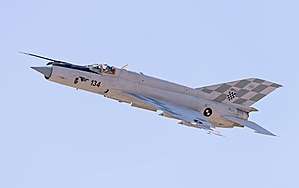
As the fleet of 12 overhauled MiG-21s was originally planned to remain active only until late 2011, Croatia was eyeing a replacement aircraft already by late 2008. It was projected that a new type be selected by late 2009 and that the first aircraft start entering service by 2011. Such plans were put into question by the global economic crisis which severely affected the Croatian economy and in late 2010 it was officially unveiled that no new aircraft were envisaged to enter service.
The Defence Ministry finally announced in June 2013 that the Ukrainian firm Ukrspetsexport will provide Croatia with 8 single-seat and 4 twin-seat upgraded MiG-21 aircraft. Due to their condition only 7 of these will be refurbished Croatian air frames and the remaining 5 will be "new" aircraft. These are to remain in service by 2020 and the decision on the replacement fighter type is to be made by the end of 2016. [5][6]
2017 program restart
In July 2017, the Croatian Ministry of Defence announced it had restarted the MiG-21 replacement procurement program, and issued a request for proposals for up to 12 aircraft to five countries: Greece, Israel and the United States for the General Dynamics F-16 Fighting Falcon, Sweden for the Saab JAS 39 Gripen, and South Korea for the KAI T-50 Golden Eagle.[7]
In October 2017, the Ministry announced it had four received letters of intent for up to 18 aircraft from the United States, Israel and Greece offering various F-16 variants, as well as Sweden offering an unknown Saab JAS 39 Gripen variant. South Korea did not place a bid in the tender.[8][9]
In November 2017, Croatian media announced the offers from Sweden for the Saab JAS 39 Gripen and Israel for a mixed-fleet of A/B and C/D General Dynamics F-16 Fighting Falcon variants had been downselected from the four received letters of intent.[10] According to reports, the US bid was dismissed for being too expensive, and the F-16 Block 30 offered by Greece was dismissed for being too outdated.[11][12] Further reports insinuate the Israeli offer is leading for being most price-competitive, as well as opening up additional opportunities for defence cooperation.[13]
On 29 March 2018, the Croatian Government unanimously adopted a decision on the procurement of 12 F-16 C/D Barak Block 30 aircraft from Israel for 2.9 billion kunas (around 420 million euros). Besides 12 jets, Croatia will get two flight simulators, training for its pilots and maintenance staff in Israel, aircraft weapons, a package of spare parts and equipment for ground support, infrastructure construction and adaptation, and three years of support, including the presence of Israeli instructors in Croatia. The first two jets are expected to be delivered in 2020, and the rest by 2022.[14]
Modernization and procurement programs
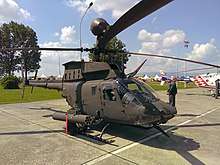
- Overhaul of the existing fleet of 14 Mil Mi-17 transport helicopters (11 Mi-8MTV-1 and 3 Mi-8T) during 2013-2015. Initial six helicopters have been overhauled by 2014 for 81 million Croatian Kuna and the remaining eight are to follow. Cost of program - 200 million Croatian Kuna. However Defence minister Ante Kotromanovic is holding talks with the US on the possibility of purchasing 15 used UH-60 Black Hawk helicopters.[15] These would replace older Mi-17 helicopters currently in service but scheduled to undergo overhaul in 2015, cost of which is uncertain due to difficulties in acquiring spare parts and dependence on Russia's willingness to overhaul or supply spare parts thus undermining Croatia's own national interests and security. If Black Hawks are purchased Croatia would sell its older Mi-17 helicopters to third parties for roughly 5 million USD per unit.
- Modernization of the combat aircraft fleet. It was decided to overhaul the fleet of MiG 21 and purchase additional aircraft as an interim solution till 2019-2020 when a new fighter will be purchased. Cost of program – 105 million Croatian Kuna.[16]
- Plans to purchase at least one SAM battery with a range that exceeds 10 km, most likely candidates are Crotale NG or second hand systems from a number of NATO allies. Cost of program - unknown [17] although there are plans to move entire air defence segment of the air force to land forces component of Croatian Armed Forces thus reducing the number of service personal in the air force.
- Integration of AN/FPS-117 Radar network in to NATO Radar network consisting of 5 radar stations across Croatia - 50 million Kuna.[17]
- $500 million purchase of 12 F-16 C/D Barak 2020 from Israel, the aircraft will undergo SLEP, and are comparable to F-16I Sufa Block 52. Purchase includes 3 spare engines and 2 simulators.[18]
Aircraft
Current inventory
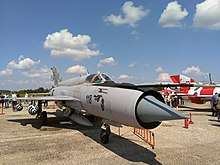

| Aircraft | Origin | Type | Variant | In service | Notes | |
|---|---|---|---|---|---|---|
| Combat Aircraft | ||||||
| MiG-21 | Soviet Union | fighter | MiG-21bis/UMD | 12[19] | ||
| F-16 Fighting Falcon | United States | multirole | F-16C/D Barak 2020 | 12 on order – Obtained from Israel[20] | ||
| Aerial Firefighting | ||||||
| Air Tractor AT-802 | United States | fire suppressor | AT-802A/AT-802F | 6[19] | ||
| Bombardier CL-415 | Canada | water bomber | CL-415 | 6[19] | ||
| Helicopters | ||||||
| UH-60 | United States | utility | UH-60M | 2 on order[21][22] | ||
| Mil Mi-17 | Russia | transport/SAR | Mi-8/17/171 | 24[19] | ||
| Bell OH-58 | United States | armed scout | OH-58D | 16[23] | ||
| Bell 206 | United States | trainer | Bell 206B-3 | 8[19] | ||
| Trainer Aircraft | ||||||
| Pilatus PC-9 | Switzerland | trainer | PC-9M | 17[19] | ||
| Zlin Z 42 | Czech | trainer | Z-242L | 5[19] | ||
Retired
Previous aircraft operated by the Air Force were the UTVA-75, An-2, An-32, CL-215, MD 500 and Mi-24. [24][25][26]
See also
References
- ↑ Krizmanić, Goran. "OSRH - Glavna". www.osrh.hr.
- ↑ "Orbats - Scramble". Scramblemagazine.nl. Retrieved 2016-03-31.
- ↑ Air Forces Monthly, Feb 2013 Edition, Key Publishing
- 1 2 "Archived copy". Archived from the original on February 1, 2015. Retrieved January 29, 2015.
- ↑ "Croatia to refurbish MiGs, delaying new combat type". Flightglobal.com. Retrieved 24 December 2014.
- ↑ 2013-06-26T10:18+02:00 10:18 26.06.2013 (2013-06-26). "Ukraine wins tender to repair Croatian MiG-21 fighters". En.interfax.com.ua. Retrieved 2016-03-31.
- ↑ Tabak, Igor (21 July 2017). "Croatia issues RfP for multirole fighter aircraft". IHS Jane's 360. Archived from the original on 23 November 2017. Retrieved 23 November 2017.
- ↑ Lozančić, Branko (26 September 2017). "Replacement being sought for MiG's – Krstičević with his Swedish colleague". Voice of Croatia. Archived from the original on 23 November 2017. Retrieved 23 November 2017.
- ↑ Adamowski, Jaroslaw (4 October 2017). "4 nations bid for Croatian fighter jet deal; F-16 and Gripen under consideration". Defense News. Warsaw. Archived from the original on 23 November 2017. Retrieved 23 November 2017.
- ↑ Egozi, Arie (27 November 2017). "Israel offers Croatia mixed fleet of F-16s". Flight Global. Tel Aviv. Archived from the original on 29 November 2017. Retrieved 29 November 2017.
- ↑ Rojkes Dombe, Ami (22 November 2017). "Israel, Sweden Compete to Replace Croatia's Outdated MiG-21s". Israel Defense. Archived from the original on 23 November 2017. Retrieved 23 November 2017.
- ↑ "Croatian MoD downselects Sweden, Israel bids to replace outdated MiG-21s". Air Recognition. 20 November 2017. Archived from the original on 23 November 2017. Retrieved 23 November 2017.
- ↑ "Croatia leaning towards Swedish Gripens or Israeli F-16s". Alert 5. 22 November 2017. Archived from the original on 23 November 2017. Retrieved 23 November 2017.
- ↑ "VLADA ODLUČILA O KUPOVINI AVIONA Plenković: 'Ova odluka predstavlja našu političku volju, te jačanje suradnje s SAD-om i Izraelom'".
- ↑ Krešimir Žabec (2014-05-27). "Umjesto ruskih Mi-8, MORH želi polovne Black Hawke". Jutarnji.hr. Retrieved 2016-03-26.
- ↑ "Remont sedam migova i nabava još pet za 13,9 milijuna eura". Večernji.hr. Retrieved 24 December 2014.
- 1 2 "HV će imati bojnu od 500 vojnika za ratovanje u svijetu". Večernji.hr. Retrieved 24 December 2014.
- ↑ "Doznajemo kako će izgledati hrvatski F-16".
- 1 2 3 4 5 6 7 "Hrvatska raspolaze s 49 vojnih-aviona i 48 helikoptera". vecernji.hr. Retrieved 28 December 2016.
- ↑ "Israel Sells Croatia 12 F-16 Fighter Jets for $500 Million". haaretz.com. Retrieved 31 March 2018.
- ↑ "USA donates two Black Hawk helicopters to Croatia". thedubrovniktimes.com. Retrieved 12 October 2018.
- ↑ "OTKRIVAMO: AMERIKA NAM POKLANJA DVA POTPUNO NOVA MOĆNA HELIKOPTERA BLACK HAWK! Hrvatskoj vojsci strateški saveznici doniraju najmodernije letjelice". jutarnji.hr. Retrieved 12 October 2018.
- ↑ Tabak, Igor (5 December 2016). "Croatia receives final OH-58D Kiowa helicopters". IHS Jane's 360. Zagreb, Croatia. Retrieved 5 December 2016.
- ↑ "Croatian Air Force Aircraft Types". www.aeroflight.co.uk.
- ↑ "Croatian Air Force Aircraft Types Not Used". www.aeroflight.co.uk.
- ↑ "Equipment of Croatian Air Force (HRZ)". Vojska.net. Retrieved 2018-07-16.
Bibliography
External links
| Wikimedia Commons has media related to Air force of Croatia. |
- Official website (English version)
- War is Boring
